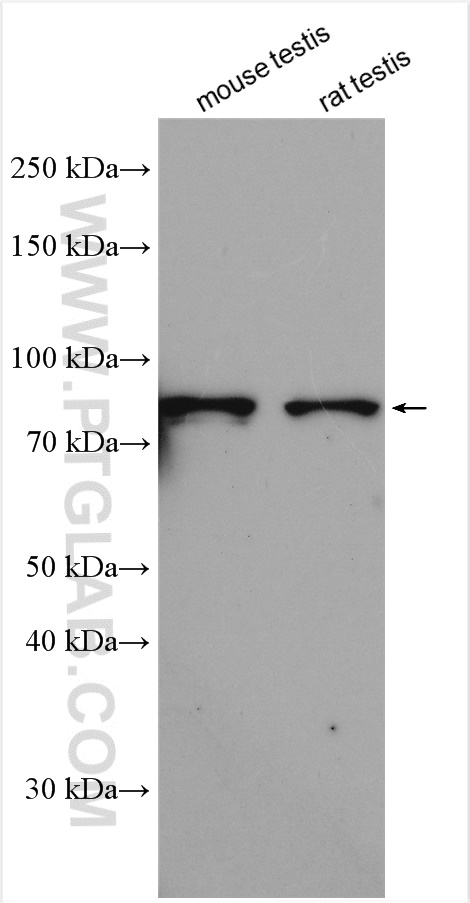验证数据展示
经过测试的应用
| Positive WB detected in | mouse testis tissue, rat testis tissue |
推荐稀释比
| 应用 | 推荐稀释比 |
|---|---|
| Western Blot (WB) | WB : 1:1000-1:4000 |
| It is recommended that this reagent should be titrated in each testing system to obtain optimal results. | |
| Sample-dependent, Check data in validation data gallery. | |
产品信息
29787-1-AP targets NSUN7 in WB, ELISA applications and shows reactivity with human, mouse, rat samples.
| 经测试应用 | WB, ELISA Application Description |
| 经测试反应性 | human, mouse, rat |
| 免疫原 | NSUN7 fusion protein Ag31860 种属同源性预测 |
| 宿主/亚型 | Rabbit / IgG |
| 抗体类别 | Polyclonal |
| 产品类型 | Antibody |
| 全称 | NOL1/NOP2/Sun domain family, member 7 |
| 别名 | FLJ14001 |
| 计算分子量 | 718 aa, 81 kDa |
| 观测分子量 | 80 kDa |
| GenBank蛋白编号 | BC036568 |
| 基因名称 | NSUN7 |
| Gene ID (NCBI) | 79730 |
| RRID | AB_2923609 |
| 偶联类型 | Unconjugated |
| 形式 | Liquid |
| 纯化方式 | Antigen affinity purification |
| 储存缓冲液 | PBS with 0.02% sodium azide and 50% glycerol , pH 7.3 |
| 储存条件 | Store at -20°C. Stable for one year after shipment. Aliquoting is unnecessary for -20oC storage. |
背景介绍
NSUN7 (NOP2/Sun RNA methyltransferase family member 7) is involved in mitochondrial rRNA processing in post-meiotic sperm and is predicted to act upstream of or within flagellated sperm motility and sperm mitochondrion organization. In humans, Nsun7 encodes a protein with 718-amino acid and 3697-bp belonging to the methyltransferase superfamily (PMID: 37173708). The failure to produce NSUN7 would lead to the impairment in activity and motility of sperm flagella, leading to sperm motility deficit and infertility (PMID: 25702163).
实验方案
| Product Specific Protocols | |
|---|---|
| WB protocol for NSUN7 antibody 29787-1-AP | Download protocol |
| Standard Protocols | |
|---|---|
| Click here to view our Standard Protocols |
